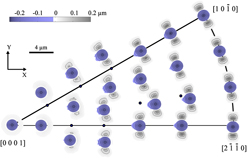Crossref Citations
This article has been cited by the following publications. This list is generated based on data provided by
Crossref.
Rusakova, A. V.
Lubenets, S. V.
Fomenko, L. S.
and
Moskalenko, V. A.
2012.
Structural homogeneity of nanocrystalline VT1-0 titanium. Low-temperature micromechanical properties.
Low Temperature Physics,
Vol. 38,
Issue. 10,
p.
980.
Hryniewicz, Tadeusz
Rokosz, Krzysztof
Valíček, Jan
and
Rokicki, Ryszard
2012.
Effect of magnetoelectropolishing on nanohardness and Young's modulus of titanium biomaterial.
Materials Letters,
Vol. 83,
Issue. ,
p.
69.
Li, Ling
Shen, Luming
Proust, Gwénaëlle
Moy, Charles K.S.
and
Ranzi, Gianluca
2013.
Three-dimensional crystal plasticity finite element simulation of nanoindentation on aluminium alloy 2024.
Materials Science and Engineering: A,
Vol. 579,
Issue. ,
p.
41.
Yang, Jia
Xu, Jin
and
Zhang, Guang-Ping
2013.
Deformation and damage behavior of colonies in a small-sized α/β Ti alloy.
Scripta Materialia,
Vol. 68,
Issue. 9,
p.
715.
Qin, Hong
Jonas, John J.
Yu, Hongbing
Brodusch, Nicolas
Gauvin, Raynald
and
Zhang, Xiyan
2014.
Initiation and accommodation of primary twins in high-purity titanium.
Acta Materialia,
Vol. 71,
Issue. ,
p.
293.
Lecomte, Jean Sébastien
Nguyen, L.T.
Abbès, F.
Schuman, C.
and
Raulot, J.M.
2014.
Contribution of the Nanoindentation to the Study of HCP Metals.
Materials Science Forum,
Vol. 783-786,
Issue. ,
p.
2327.
Tasan, C.C.
Hoefnagels, J.P.M.
Diehl, M.
Yan, D.
Roters, F.
and
Raabe, D.
2014.
Strain localization and damage in dual phase steels investigated by coupled in-situ deformation experiments and crystal plasticity simulations.
International Journal of Plasticity,
Vol. 63,
Issue. ,
p.
198.
Selvarajou, Balaji
Shin, Joong-Ho
Ha, Tae Kwon
Choi, In-suk
Joshi, Shailendra P.
and
Han, Heung Nam
2014.
Orientation-dependent indentation response of magnesium single crystals: Modeling and experiments.
Acta Materialia,
Vol. 81,
Issue. ,
p.
358.
Rugg, D.
Britton, T.B.
Gong, J.
Wilkinson, A.J.
and
Bagot, P.A.J.
2014.
In-service materials support for safety critical applications – A case study of a high strength Ti-alloy using advanced experimental and modelling techniques.
Materials Science and Engineering: A,
Vol. 599,
Issue. ,
p.
166.
Engels, P. S.
Begau, C.
Gupta, S.
Schmaling, B.
Ma, A.
and
Hartmaier, A.
2014.
Nanomechanical Analysis of High Performance Materials.
Vol. 203,
Issue. ,
p.
285.
Fizanne-Michel, C.
Cornen, M.
Castany, P.
Péron, I.
and
Gloriant, T.
2014.
Determination of hardness and elastic modulus inverse pole figures of a polycrystalline commercially pure titanium by coupling nanoindentation and EBSD techniques.
Materials Science and Engineering: A,
Vol. 613,
Issue. ,
p.
159.
Tasan, C.C.
Diehl, M.
Yan, D.
Zambaldi, C.
Shanthraj, P.
Roters, F.
and
Raabe, D.
2014.
Integrated experimental–simulation analysis of stress and strain partitioning in multiphase alloys.
Acta Materialia,
Vol. 81,
Issue. ,
p.
386.
Yang, J.
Song, Z.M.
Lei, L.M.
and
Zhang, G.P.
2014.
Detecting mechanical properties of microstructure units in Ti–6.5Al–3.5Mo–1.5Zr–0.3Si alloy.
Materials Science and Engineering: A,
Vol. 617,
Issue. ,
p.
84.
Sánchez-Martín, R.
Pérez-Prado, M.T.
Segurado, J.
and
Molina-Aldareguia, J.M.
2015.
Effect of indentation size on the nucleation and propagation of tensile twinning in pure magnesium.
Acta Materialia,
Vol. 93,
Issue. ,
p.
114.
Wang, Shiying
Zhang, Yudong
Schuman, Christophe
Lecomte, Jean-Sebastien
Zhao, Xiang
Zuo, Liang
Philippe, Marie-Jeanne
and
Esling, Claude
2015.
Study of twinning/detwinning behaviors of Ti by interrupted in situ tensile tests.
Acta Materialia,
Vol. 82,
Issue. ,
p.
424.
Britton, T. B.
Dunne, F. P. E.
and
Wilkinson, A. J.
2015.
On the mechanistic basis of deformation at the microscale in hexagonal close-packed metals.
Proceedings of the Royal Society A: Mathematical, Physical and Engineering Sciences,
Vol. 471,
Issue. 2178,
p.
20140881.
Sánchez-Martín, R.
Zambaldi, C.
Pérez-Prado, M.T.
and
Molina-Aldareguia, J.M.
2015.
High temperature deformation mechanisms in pure magnesium studied by nanoindentation.
Scripta Materialia,
Vol. 104,
Issue. ,
p.
9.
Pathak, Siddhartha
and
Kalidindi, Surya R.
2015.
Spherical nanoindentation stress–strain curves.
Materials Science and Engineering: R: Reports,
Vol. 91,
Issue. ,
p.
1.
Choudhury, Soud Farhan
and
Ladani, Leila
2015.
Single Crystal Plasticity Finite Element Analysis of Cu6Sn5 Intermetallic.
Metallurgical and Materials Transactions A,
Vol. 46,
Issue. 3,
p.
1108.
Yamanaka, Kenta
Saito, Wataru
Mori, Manami
Matsumoto, Hiroaki
and
Chiba, Akihiko
2015.
Preparation of weak-textured commercially pure titanium by electron beam melting.
Additive Manufacturing,
Vol. 8,
Issue. ,
p.
105.





